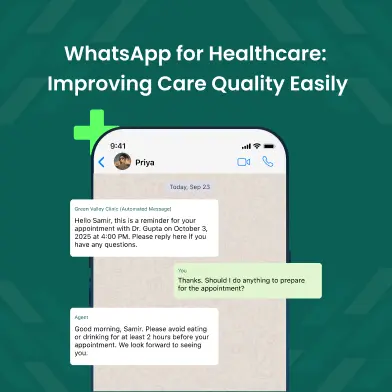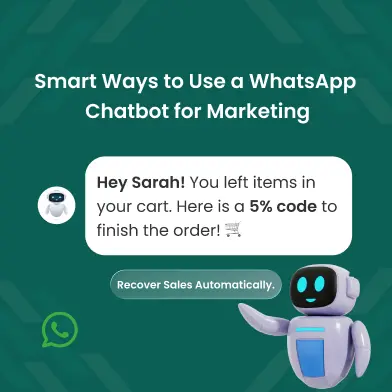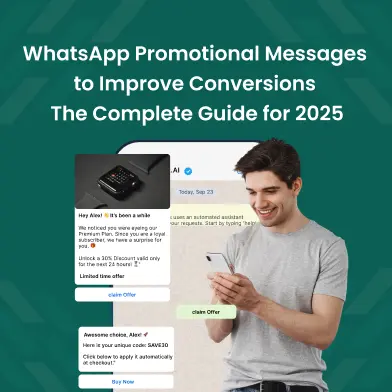Table of Contents
Introduction: Why This Is More Important Than Ever
Have you ever gotten an order update on WhatsApp and thought, “Wow, that’s fast”? People today expect to be able to talk to businesses right away, whether it’s to confirm an order, get an update on delivery, remind them of an appointment, or let them know about a payment. Email can be delayed, SMS can be missed, but WhatsApp is nearly always opened. This is a great chance for businesses.
But a lot of businesses have trouble sending WhatsApp transactional messages that work, such getting their templates rejected, having low delivery rates, or having inconsistent branding. This post will show you exactly how to get past such problems and send smooth, dependable transactional notifications through WhatsApp.
What are WhatsApp messages for transactions?
Transactional messages on WhatsApp are automatic messages that are sent to consumers after they do something or finish a transaction. They’re not marketing blasts; they’re updates that your consumers expect to get.
Some examples are:
- Updates on WhatsApp about orders in real time
- Sending confirmations of payments using WhatsApp
- Reminders and changes to appointments
- Updates on the progress of your delivery and tracking information
- Notifications about account activity or security
These messages help establish trust, make customers happier, and cut down on support calls because your users get the information they need immediately.
Why should you use WhatsApp for transactional messages?
1. High Open Rates
More than 90% of WhatsApp messages are opened, which is much higher than email or SMS.
2. Delivery right away
Notifications show up on consumers’ phones virtually right away.
3. Interactive Experience
Customers can respond, ask questions, or see rich material including photos, PDFs, and buttons.
4. Reach all across the world
WhatsApp is a truly global medium with over 2 billion active users.
5. Trustworthiness of the Brand
Using an official WhatsApp Business API or a verified green tick makes your business look more trustworthy and stops people from pretending to be you.
How to Send WhatsApp Transactional Messages Effectively: A Step-by-Step Guide
Step 1: Get the WhatsApp Business API set up
You require the WhatsApp Business API (WABA) to send a lot of transactional messages. You can get this in one of two ways:
- Directly through Meta (for big businesses), or
- Through a WhatsApp Business Solution Provider (BSP) that is official, such WBotz, Twilio, or MessageBird.
This API adds functionality for automation, safe delivery, and compliance.
Step 2: Check Your Business
WhatsApp needs to verify businesses to cut down on spam. Provide:
- The name of your business in the law
- Documents for registering for taxes or a business
- Your official site
You can start sending template messages after they are authorized.
Step 3: Make and send message templates
WhatsApp’s template guideline must be followed by all transactional communications.
Examples:
Update on your order: “Hey [Name], your order #[OrderID] has been shipped and will be there on [Date].”
“Thanks for your payment of [Amount] for order #[OrderID].”
Use language that is impartial and not advertising. Add variables, such as the customer’s name or order number, to make communications more personal. In your WhatsApp Business Manager, send these templates in for approval.
Step 4: Connect to Your Systems
- Link your API to your ERP, CRM, or eCommerce site. This lets you communicate real-time order updates on WhatsApp or payment confirmations on WhatsApp as a transaction happens.
- You can utilize middleware technologies like Zapier, Make, or custom webhooks, or you can use native connectors on many sites.
Step 5: Make your messages more personal and break them up into groups
Personalizing even transactional messages is a good idea. Tips:
- Add the customer’s first name.
- Say “Hi from [Brand Name]!” in your greets.
- Give some background information, like order IDs, product names, or dates.
This makes your communication sound like a person, not a robot.
Step 6: Add things that people can interact with
Make the experience better with:
- Buttons: “Order Status,” “Get in touch with support,” “See Invoice”
- Rich Media: Pictures of products, PDF invoices, and maps to trace deliveries
- Fast Responses: Set responses for customers
These things make things easier and get things done right away.
Step 7: Keep an eye on delivery and engagement
Keep an eye on the following via your BSP’s analytics dashboard:
- Rates of delivery
- Read receipts
- Click-through rates for buttons
- Answers from customers
Use data to improve your templates and scheduling.
Step 8: Follow the rules
WhatsApp has tight rules. Don’t put ads in transactional communications. Always provide them the choice to opt out of marketing messages. Make sure your business is authenticated and your templates are approved.
1. Increase Customer Satisfaction by Sending WhatsApp Transactional Messages Effectively
Your customers feel like they know what’s going on and that you care about them.
2. Cut down on support work
Fewer “Where is my order?” or “Did you get my money?” calls.
3. Build trust in your brand
Consistent and verified messaging makes people loyal to your brand.
4. More Involvement
WhatsApp notifications are more likely to be opened, read, and acted on than emails.
5. Operations in Real Time
You may tell clients about changes right away, which cuts down on mistakes and delays.
Example from the real world
Example: An online store
WBotz helped an online store add WhatsApp transactional messages.
- Customers got fast payment confirmations over WhatsApp.
- Real-time order updates cut down on support tickets by 30%.
- Interactive buttons allow people see where their packages are right away.
The result was higher customer satisfaction levels and more repeat purchases.
Things You Shouldn’t Do
- Using promotional language in transactional templates will get you turned down.
- Not making communications personal—customers don’t pay attention to generic updates.
- You miss chances to optimize if you don’t keep an eye on performance.
If you don’t verify, you won’t be able to use the API right away.
Questions and Answers About WhatsApp Transactional Messages
Q1. Is it okay to put ads in WhatsApp messages that are for business?
No. Transactional communications must only convey information. Marketing campaigns should have promotional material.
Q2. Do I require the WhatsApp Business API to deliver messages about transactions?
Yes, for size and rules. The usual WhatsApp Business App is for tiny, manual tasks.
Q3. How quickly do WhatsApp transactional messages go to their destination?
Usually within seconds, as long as the buyer is online and the template is approved.
Q4. Is it possible to automatically send payment confirmations using WhatsApp?
Absolutely. Connect your payment gateway or CRM to send these alerts right away.
Q5.What happens if my template is turned down?
Change the phrasing to make it more neutral and send it back for approval.
Final Thoughts and a Call to Action
WhatsApp transactional messages are no longer just nice to have; they’re a must-have for staying competitive. You can keep clients happy at every step by using the WhatsApp Business API, making authorized templates, and connecting it to your systems. This lets you send payment confirmations and real-time order updates.
Try a platform like WBotz today if you want to make it easier to talk to your customers. It’s designed to enable businesses send WhatsApp transactional messages quickly, legally, and on a large scale.


